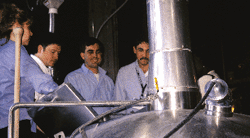

As part of the conference, attendees toured two Chicago landmark food and beverage production facilities -- the Eli's Cheesecake plant and the Goose Island Wrigleyville Brewery -- before strolling over to Wrigley Field to watch the Chicago Cubs defeat the Arizona Diamondbacks under the arcs as guests of FMC FoodTech.
PLANTtech 2000 confronted a wide range of manufacturing issues: automation; systems integration; continuous improvement; co-packing; food safety; HACCP; energy management; maintenance management; team operations; manufacturing flexibility; project management and supply-chain integration. Representatives of The Dannon Company received Food Engineering's 2000 New Plant Of The Year Award (FE June, '00) at a luncheon in their honor.

Changeovers, convenience and co-packing
Early arrivals attended a Sunday pre-conference seminar addressing packaging issues.Costly changeover time can be converted to profitable production time, said Jerry Claunch, president of the manufacturing-consulting firm Claunch & Associates, which has worked for food companies such as Kraft, Kellogg and Pepsi-Cola. "Don't wait for automation to reduce changeover time," Claunch advised. "Start with low-cost improvements" which can reduce changeover time by up to 75 percent.
The first 30 percent is easy to identify and implement. "Quick changeover" means "tool-less changeover," he continued. Changeovers typically require adjusting many threaded parts. He demonstrated threadless parts which can minimize changeover time. Claunch cited a soft-drink plant where changeover time on a case-packer was reduced from 53 minutes to 41/2 minutes in just two months by replacing threaded parts with tool-less parts and twice videotaping changeover procedures.
Paul Torniainen, senior packaging engineer at General Mills, discussed the manufacturing challenges of convenience packaging. Torniainen helped develop the Colombo Spoon In A Snap package, which features an injection-molded overcap incorporating spoon parts which the consumer assembles to eat the yogurt.
Torniainen reviewed convenience packages from several food companies which all had one thing in common: they're more expensive than the conventional package. "They require more packaging material, or more expensive packaging material, or more complicated equipment to produce, or a combination of these," he pointed out. He suggested ways to improve the odds of success in developing a convenient package. Among them:
- Accept up-front that convenient packaging will cost you more, so focus on mitigating the cost impact.
- Accept that long-term growth is painful in the short term. Change involves a new learning curve which firms with a short-term focus may not accept.
- Design for flexibility: Use conventional equipment as much as possible.
- Understand your process; perform design experiments and abide by them.
Co-packing can minimize financial exposure when introducing new products; rationalize internal manufacturing capabilities; allow the contracting firm to focus on core competencies such as marketing; take advantage of outside technological expertise; improve manufacturing flexibility; and boost speed to market. Disadvantages: more expensive manufacturing costs and additional facilities to manage. One should select a co-packer who understands his costs; is financially stable; is strategically located to minimize distribution costs; has the available capacity; has required QA and food-safety programs in place; and has the manufacturing and engineering infrastructure to produce your product, Tonkin concluded.
Integrating plant with enterprise
Dr. Malcolm Beaverstock, manager of advanced control and simulation at General Mills, keynoted the conference by addressing "the changing face of food automation."The changing face of business with emphasis on price/value relationships, innovation, speed to market, asset utilization, e-commerce, increasing regulatory pressures and optimizing multiple objectives is changing plant focus to actionable information, Beaverstock observed. This requires broad connectivity from procurement through marketing and sales, and a changing infrastructure to "manage the babble." At the plant level this means focusing on a broad range of applications including maintenance, quality, compliance, HACCP, SPC, recipe management, production planning, engineering, process simulation, lot tracking and distribution. Application focus in turn means changing the scope of control to "tell us what we're doing while we're doing it."
Beaverstock outlined a three-tier approach to changing applications: the database, the application itself, and its presentation via open, seamless integration for universal access. This changes skill requirements, requiring an understanding of process dynamics and control basics (critical to achieving fast changeovers and shorter production runs), and understanding the interactions between control, information and quality. "The person owning the application defines plant operations" and in effect makes business decisions, said Beaverstock. "Changes are rippling down to people's skill requirements."
Integrating plant-floor information with upper-level business systems into "the seamless enterprise" must be simple and transparent, said Steven Bing, manager of business engineering at Kraft Foods. Effective connections utilize the right infrastructure, application functionality, high-performance work systems, a continuous improvement process, and the right IT architecture. At Kraft, a manufacturing execution system (MES) integrates the plant with the enterprise systems. An MES data repository receives real-time control data from the plant floor in the form of transaction objects such as SPC, downtime, weight control, yields, waste, HACCP and more. The repository consolidates this data into performance measure such as order compliance and yield for corporate management, and integrates with supply-chain systems linked to suppliers, co-manufacturers and customers. The system integrates plant operators and other users with business terms for easy reporting and charting, and incorporates an Effectiveness Improvement Process which standardizes and simplifies work systems, helps train and certify users, and audits work systems to let users know howthey are doing. "People and work systems must be aligned to achieve dramatic business results," said Bing.
SPC for HACCP
"Continuous improvement is a never-ending journey," said Dr. Syed Hussain, director of technical services at ConAgra Refrigerated Prepared Foods. Continuous improvement measures reductions in costs, cycle-time, lead-time, waste and inventory while measuring improvements in throughput, productivity and employee morale. Improvement combines the knowledge and creativity of people with good data, statistical process control (SPC) and information technology. ConAgra uses Quality Improvement (QI) Teams and SPC to eliminate the causes of defects, identify process variations and adjust the process to eliminate the root causes of defects. Hussain presented a case study where a cross-functional QI team applied SPC software to further reduce low limits of generic E. coli on turkey carcasses as part of HACCP.
Re-engineering and maintenance
The five-person Bulk Freeze Improvement Team from the Pillsbury/Green Giant frozen-vegetable plant at Belvidere, Ill, described how the team re-engineered a 42-ft. tunnel freezer -- originally designed to IQF-freeze peas and corn -- to efficiently freeze 61/2 million tons of rice and 12 million tons of pasta per year. By applying its problem-solving skills, the team reduced ergonomic risk by 84 percent, waste by 2.4 percent (440,000 lbs. per year), repair costs by 94 percent ($15,800), annual labor and training costs by $2,000, as well as customer rice costs and pasta costs.Doug Wittenberg, area manager for control and electrical maintenance at Campbell Soup, Ltd., Toronto, profiled maintenance organization, strategy and systems at the 70-year old plant.
The Campbell Maintenance Management System (CMMS), a prototype software, forms the foundation of the plant's maintenance systems, Wittenberg explained. CMMS integrates plant-floor data, production planning, machine histories and a downtime/reliability system called PMIS to isolate problem equipment and maintenance priorities. CMMS tracks work orders, spare-part usage and maintenance time for each piece of equipment; records preventive-maintenance checks conducted and overdue; and "can track time, money and resources over a year," said Wittenberg. It also supports predictive-maintenance data from technologies such as oil analysis, vibration analysis and infra-red analysis. Nineteen of the plant's 59 maintenance people form a cross-functional RBM (Reliability Based Maintenance) Team, which specializes in predictive maintenance and root-cause analysis.
Maintenance strategy is part of the plant's overall "Vision 2000" which aims at boosting production efficiency to 85 percent without adding labor or capital assets. Results to date: Manufacturing efficiency 83.7 percent; cases per labor hour up 9 percent since 1998; cans per minute up to 415, nearly double the 1995 rate.

Focus on food safety
Dr. Douglas Powell, director of the Agri-Food Risk Management and Communications Project at the University of Guelph and editor of the Internet service Food Safety Net, addressed the manufacturer's role in food safety. "Good risk assessment or science, good management and good communications -- we need all three," said Powell. "We often do good science but fail in the communications aspect. Most important is the management -- are you reducing those risks?" He reviewed recent foodborne disease outbreaks traced to food plants, one "not an act of God but a series or a culmination of basic management failures," he observed. "You never say 'no' to risk. If you don't communicate it, somebody else will do it for you, and you probably won't like the way they do it."
Additional interventions tested by Emmpak include UV light, acidified sodium chlorite and ozonated water. Refrigerated and frozen sections of Emmpak's new distribution center, currently under construction, will be flushed with synthetic liquid air -- a breathable refrigerant used like liquid nitrogen to supplement mechanical refigeration. Emmpak is also testing irradiation of ground beef and sliced deli meats at the Titan electron-beam plant in Sioux City, Iowa.

Dr.Timothy Freier, director of educational services at the Silliker Laboratories Group, reviewed the current regulatory status of HACCP, including the Listeria reassessment required by FSIS in ready-to-eat meat/poultry plants and FDA's proposed HACCP rule for juices. USDA and FDA are jointly working on a HACCP proposal for eggs, and FDA has developed a voluntary pilot HACCP program for dairy plants.
HACCP has not yet reached its full potential, Freier observed, because of weak prerequisite programs (SSOPs and GMPs), lack of top-management committment, priority of production over HACCP; inclusion of non-food-safety issues in HACCP plans; weak CCP validations and hazard analyses; inadequate training, and documentation. improvement.
Super supply chain
Chuck Odom, vice president for information technology at Odom's Tennessee Pride, concluded PLANTtech 2000 with a dynamic discussion of Odom's supply-chain solution, which integrates the company's headquarters and three sausage plants with its hog and ingredient suppliers, third-party distribution centers, and retail and food-service customers nationwide.Odom's system integrates SCT's Adage ERP software, SCT's Fygir advanced-planning and scheduling software, and an ISIS forecasting package with Microsoft SQL software for real-time data collection and reporting plus bar-code integration. Among major results, Odom reported: reduced production costs through fewer changeovers; reduced inventory costs across the supply chain; integration of forecasting, planning, scheduling and ERP; lot control and tracking of work-in-process; lower scrap rates; higher yields; increased sales by eliminating out-of-stock conditions; improved customer satisfaction through shorter cycle times. "If you can dream it, if you can think it, you can do it!" said Odom of his new system.